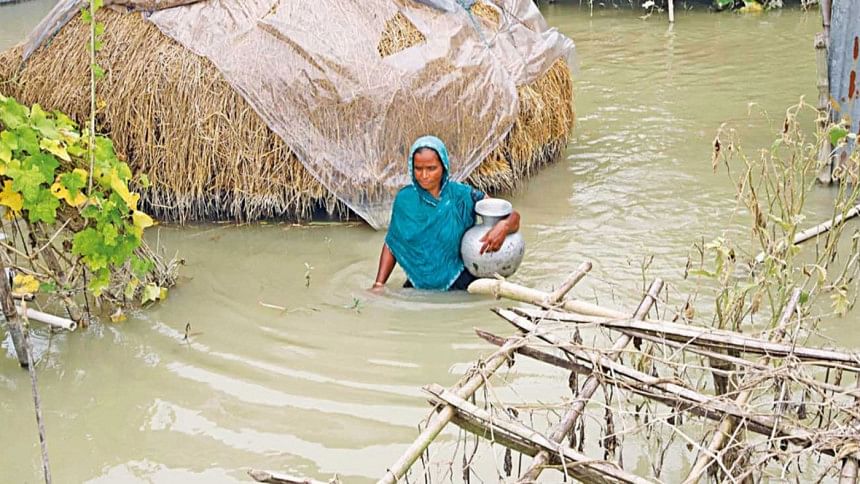Is a global goal on adaptation possible?

At the historic Paris Agreement on Climate Change made at the 21st Conference of Parties (COP21) of the United Nations Framework Convention on Climate Change (UNFCCC) in 2015, all the countries of the world agreed on a global goal on mitigation as well as setting a global goal on adaptation.
The global goal on mitigation was relatively simple, as it was to keep the global temperature below 1.5 degrees Celsius. This takes into account the emissions of different greenhouse gases by each country and the global warming potential of each of these gases to calculate how much each country is contributing to raising the global temperature. Each country, in turn, has to submit its plans for reducing its emissions—called the Nationally Determined Contribution (NDC)—making it possible to calculate if each country is doing enough or not. It is also possible to calculate the cumulative effect of all the NDCs, to see whether we are on track to stay below 1.5 degrees. Unfortunately, we are still not compliant with the global goal and it will be necessary for all countries to enhance the ambition of their respective NDCs by the time COP26 is held in Glasgow, Scotland in November this year.
The calculation of the global goal on mitigation and measuring progress towards reaching that goal is thus relatively simple. However, this is not the case for the global goal on adaptation, because adaptation takes place in different locations in highly local circumstances, and making an aggregate global goal is extremely technically challenging. What progress has been made so far in trying to come up with metrics and indicators to track progress towards a global goal on adaptation, which is supposed to be discussed and agreed on at COP26?
The first aspect of a global goal on adaptation is, in fact, the issue of funding for adaptation, and this is quite simple. Developed countries had promised to provide USD 100 billion a year from 2020 onwards to developing countries to tackle both mitigation and adaptation. However, 2020 has come and gone but they are yet to deliver the full amount. The developing countries had demanded that 50 percent of climate finance should go to the most vulnerable developing countries for adaptation. Till now, only 20 percent of climate finance has actually gone to support adaptation. Hence, there are two major expectations that are yet to be fulfilled by developed countries—namely, delivering USD 100 billion of climate finance and giving half of that, USD 50 billion, to support adaptation. If we consider adaptation finance as one of the global goals on adaptation, then we have already failed the first test.
However, it is in the more technical domain of setting an adaptation goal, and also developing and agreeing metrics and indicators for measuring progress towards the goal, that there are a number of schools of thought—which different scientific groups around the world are developing, including from the Bangladeshi scientific community. One of the first aspects of deciding how to set an adaptation goal and then how to measure progress towards achieving it, is to choose the scale of the unit of measurement. This could be at a national level where countries are preparing their respective National Adaptation Plans (NAPs) and the implementation of the NAPs could be used as a means of measuring progress. The global goal would be for every country to develop and share its NAP and then to implement it over time. This activity is happening but isn't yet incorporated into an agreed global goal on adaptation.
Another set of scales for measuring adaptation can be at the city or town level and many cities and towns around the world are preparing their respective adaptation plans, and also beginning to implement them. This set of town-based indicators could be another interesting way to measure progress. Yet another set of common scales to use are the same ecosystems in different countries and continents. For example, mountain ecosystems, delta ecosystems, forest ecosystems, islands and floodplains all over the world have some common characteristics and similar climate vulnerabilities. Hence, adaptation in one such ecosystem can be useful for people living in similar ecosystems in other countries to learn from each other. This approach would be a more ecosystem-based one, or to use the phrase in vogue, a Nature Based Solutions (NBS) approach to measuring progress on adaptation.
Whatever type of adaptation system we choose, there are two important aspects of setting a goal and then measuring progress towards the goal. One is to see which country or location is making the most progress and which the least. This produces a ranking of best to worst countries or locations, which is useful to track progress over time. However, the second aspect of aggregation of all the efforts at the national and local levels is more challenging, as it is difficult to know what the aggregate number should be. There have indeed been efforts such as in the Race to Resilience (R2R) campaign for non-state actors to try to get two billion people to become resilient, but these are not easy numbers to measure and verify.
In Bangladesh, the scientific community had come together under the banner of the Gobeshona initiative, with more than 50 universities and research institutions participating. We have become the leaders in focusing on Locally Led Adaptation (LLA), where the focus is mainly on enhancing the adaptive capacity of the most vulnerable communities in the most vulnerable locations to become more resilient. This will be one of the major features of the upcoming Mujib Climate Resilient Prosperity Plan, currently being prepared, where there will be a series of Local Adaptation Hubs set up around the country in different climate vulnerable zones to enable the communities themselves to enhance their adaptive capacity over time.
This LLA process starts with raising awareness of the problem, which has to a large extent been achieved, to then enhancing the knowledge of each different stakeholder group on what they can do to tackle the problem in their respective locations. We are on a steep learning curve on this pathway. The aim is to achieve an all-of-society approach to adaptation in Bangladesh and to share our experience with other vulnerable developing countries under the umbrella of the Climate Vulnerable Forum, which Bangladesh currently chairs.
Bangladesh has a significant opportunity to contribute to both the scientific and technical discussions on the global adaptation goal, as well as at the political level at COP26, where this issue will be discussed and negotiated.
Dr Saleemul Huq is Director of the International Centre for Climate Change and Development and Professor at the Independent University, Bangladesh.

 For all latest news, follow The Daily Star's Google News channel.
For all latest news, follow The Daily Star's Google News channel. 



Comments